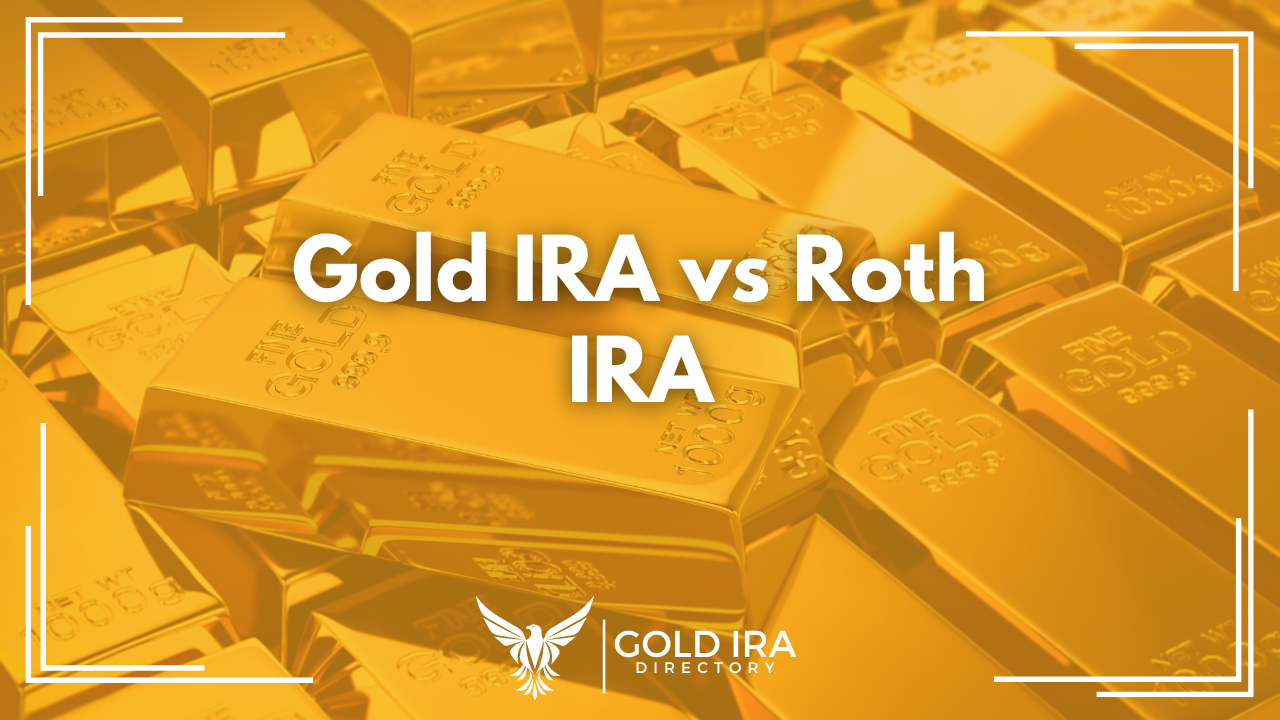
Which one is better: Gold IRA or Roth IRA?
If you’re wondering the same thing then this guide is perfect for you. We’ll take a look at the differences between these two investments to determine which one suits your needs the best.
Find the Best Gold IRA Company of Your State
Grasping the Fundamentals
Gold acts as a safeguard against inflation and political uncertainty, lacking direct tax benefits but serving as a reliable store of value throughout the years.
It’s important to grasp the tax implications and regulations concerning distributions; for instance, Roth IRA withdrawals are tax-free during retirement, whereas selling physical gold is subject to capital gains tax. It’s wise to seek the guidance of a financial adviser to help you understand these options and how they may affect your retirement and investment objectives.
Essential Distinctions
Putting your money into a Gold IRA involves investing in physical gold, such as bullion or coins that are certified by the United States Mint, with an emphasis on precious metals as the chosen asset class.
This is different from a Roth IRA, which mainly consists of securities like stocks, bonds, mutual funds, and might also feature ETFs that follow the commodity market.
Gold IRAs necessitate a self-directed IRA to facilitate investments in physical gold, whereas Roth IRAs offer greater flexibility, permitting a range of investment choices such as stocks, bonds, and mutual funds.
Roth IRAs provide notable tax benefits, as contributions are made with after-tax dollars, allowing for tax-free withdrawals in retirement. Gold IRAs provide a safeguard against inflation and political uncertainty, yet they lack the same tax advantages, since they are financed with pre-tax dollars and taxed when you take money out.
The decision between the two IRAs hinges on what the investor aims to achieve: a Gold IRA is often pursued for its ability to protect against economic downturns, reminiscent of the 2007–2008 financial crisis, whereas a Roth IRA is valued for its tax advantages and potential for growth through a well-rounded portfolio.
It’s wise to consult with a financial adviser before making any investments. They can help you understand the complexities of your options and ensure they align with your financial goals.
Gold IRA vs Roth IRA: Overview of Differences
| Feature | Gold IRA | Roth IRA |
|---|---|---|
| Investment Options | Physical gold, silver, platinum, palladium; gold-related securities | Stocks, bonds, mutual funds, ETFs |
| Tax Treatment on Contributions | Pre-tax (Traditional) or After-tax (Roth) | After-tax |
| Tax Treatment on Withdrawals | Taxed as ordinary income (Traditional) or Tax-free (Roth) | Tax-free (if qualified) |
| Income Limits | No income limits | Income limits apply |
| Required Minimum Distributions (RMDs) | Required at age 73 (Traditional) | No RMDs during owner’s lifetime |
| Early Withdrawal Penalties | 10% penalty on withdrawals before age 59½ (exceptions apply) | No penalty on contribution withdrawals; earnings may be subject to penalty |
| Contribution Limits (2024) | $7,000 ($8,000 if 50 or older) | $7,000 ($8,000 if 50 or older) |
| Storage Requirements | Must be stored in IRS-approved facility | Not applicable |
| Fees | Generally higher due to storage and custodian costs | Generally lower |
| Diversification | Provides portfolio diversification with physical assets | Allows for diversification within traditional securities |
| Inflation Hedge | Often considered a hedge against inflation | Depends on investment choices |
| Tangible Assets | Holds physical precious metals | Holds paper assets |
This table provides a clear comparison between Gold IRAs and Roth IRAs, highlighting their unique features and differences. It’s important to note that while both offer tax advantages for retirement savings, they have distinct characteristics in terms of investment options, tax treatment, and overall structure.
Establishing and Financing Alternatives
Setting up a Gold IRA typically requires working with a self-directed IRA custodian. This choice enables you to incorporate tangible gold, like coins and bullion, into your retirement savings plan. Establishing your setup requires selecting a custodian, filling out the necessary paperwork, and picking your gold investments, ensuring they adhere to IRS fineness standards.
There are several ways to fund a Gold IRA, such as transferring funds from an existing IRA or 401(k), rolling over a retirement account, or making a cash contribution. It’s important to collaborate with your custodian to make sure the process complies with IRS regulations in order to preserve the tax benefits of an IRA.
With a Roth IRA, you put in money that’s already been taxed, allowing for tax-free growth and withdrawals when you retire. Individuals can contribute to a Roth IRA by moving funds from a bank account, rolling over a current retirement account, or via deductions from their paycheck. Investment options have expanded significantly, encompassing stocks, bonds, mutual funds, and ETFs, though they do not directly involve physical gold.
Assessing the Risks

A Roth IRA serves as an investment vehicle that provides tax-free growth and withdrawals during retirement, emphasizing a well-rounded mix of stocks, bonds, and mutual funds. The Roth IRA offers certain tax benefits and the possibility of better returns over time, but it does come with market risks and depends on how well your selected investments perform. Roth IRAs come with annual contribution limits and specific rules regarding withdrawals, including penalties for accessing funds before reaching retirement age, which is quite different from gold.
Each asset class plays a distinct role in an investor’s portfolio: gold acts as a safeguard during economic downturns, while a Roth IRA serves as a growth-focused, tax-efficient option for retirement savings. Grasping these subtleties is essential for investors looking to strike a balance between risk and reward.
The Financial Considerations

Investing in gold or a Roth IRA has different financial implications, depending on aspects such as tax benefits, market fluctuations, and personal investment objectives. Gold is commonly seen as a safeguard against inflation and can be acquired in different forms, such as bullion coins, bars, or through precious metal IRAs. Nonetheless, the physical aspect of gold necessitates proper storage and insurance, which contributes to the overall expense. The price fluctuates based on the ups and downs of the commodity market, shaped by demand, mining production, and various global economic influences.
Conversely, a Roth IRA provides a tax deferral advantage, enabling investments to appreciate without tax implications, and withdrawals during retirement are also exempt from taxes. This account can accommodate various asset classes such as stocks, bonds, mutual funds, and ETFs, allowing for diversification. The Roth IRA is regulated by the Internal Revenue Service, which sets particular contribution limits and guidelines for withdrawals and required minimum distributions.
Deciding whether to invest in gold or a Roth IRA requires careful consideration of the long-term growth potential, while also taking into account market risks, associated fees, and tax consequences. Gold serves as a solid asset and can help shield against currency devaluation, whereas a Roth IRA presents a well-organized, tax-friendly method for retirement savings, allowing for a variety of investment options.
Selecting a Custodian or Broker
When selecting a custodian or broker for your Gold or Roth IRA, it’s important to take into account their experience with the particular assets you wish to invest in. When considering Gold IRAs, it’s important to find custodians who focus on precious metals. They should provide choices such as bullion coins that are recognized by the United States Mint, or bars that have a high level of fineness. These custodians ought to grasp the complexities involved in investing in physical assets, such as storage, insurance, and security protocols.
When it comes to Roth IRAs, which include a variety of investments like stocks, bonds, mutual funds, and ETFs, it’s crucial to have a broker-dealer who is skilled in these financial services. They can offer access to various investment funds, assist in building a diversified portfolio, and provide guidance on tax-advantaged strategies, including tax deferral and required minimum distributions.
Both options ought to provide reasonable fees, clear pricing, and dependable customer service. Considering the possibilities of market fluctuations and rising prices, it’s essential to choose a custodian or broker that has a solid history, adheres to regulations, and offers a reliable platform for overseeing your investments. This decision can greatly influence the effectiveness of your IRA, whether you’re using gold as a hedge or pursuing growth through a Roth IRA.
The Ultimate Decision
Deciding whether to invest in gold or a Roth IRA depends on your financial objectives, how much risk you’re willing to take, and your investment timeframe. Gold, a valuable metal, acts as a safeguard against inflation and economic instability. It can serve as a reliable store of value during challenging periods, such as the financial crisis of 2007–2008. However, its price can be quite unpredictable, swayed by elements such as mining supply, demand, and the state of the global economy.
A Roth IRA provides a tax benefit, allowing for tax-free growth and withdrawals during retirement. It provides a varied investment portfolio, encompassing stocks, bonds, mutual funds, and additional options, which may yield better returns than gold in the long run. However, it carries market risk and necessitates a solid grasp of investment choices.
In the end, it’s important that your decision reflects your investment approach, taking into account aspects such as diversification, the likelihood of returns, and how comfortable you are with risk. Gold can serve as a reliable refuge during economic downturns, but a Roth IRA might offer more significant growth opportunities and tax advantages for those saving for retirement.
Frequently Asked Questions
Is a gold IRA the most suitable investment for someone in their later years?
A gold IRA can serve as a wise investment choice for those in their later years who wish to safeguard and enhance their savings through a more secure strategy.
Is it wise to invest my IRA in gold?
Investing your IRA in gold can be a wise strategy to diversify your investment portfolio and safeguard against inflation. Nonetheless, it might not be the most suitable choice for individuals looking for significant short-term gains.
Is it possible to have both a Roth IRA and a gold IRA?
Indeed, it’s possible to maintain both a Roth IRA and a gold IRA, though it’s important to keep them in separate accounts. Gold IRAs, often referred to as precious metals IRAs, can be established as a Roth IRA using post-tax funds and necessitate the acquisition and storage of physical gold.
What are the drawbacks of a gold IRA?
A gold IRA has its drawbacks, as it tends to be more complicated and costly compared to traditional IRAs. This includes various fees such as purchase commissions, storage fees, and insurance costs, all of which can diminish your returns. Furthermore, gold IRAs limit investments to precious metals that are approved by the IRS.


